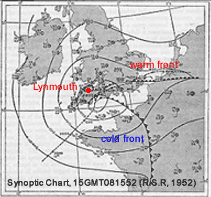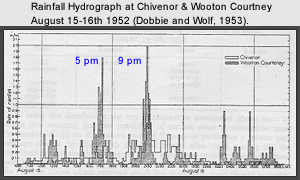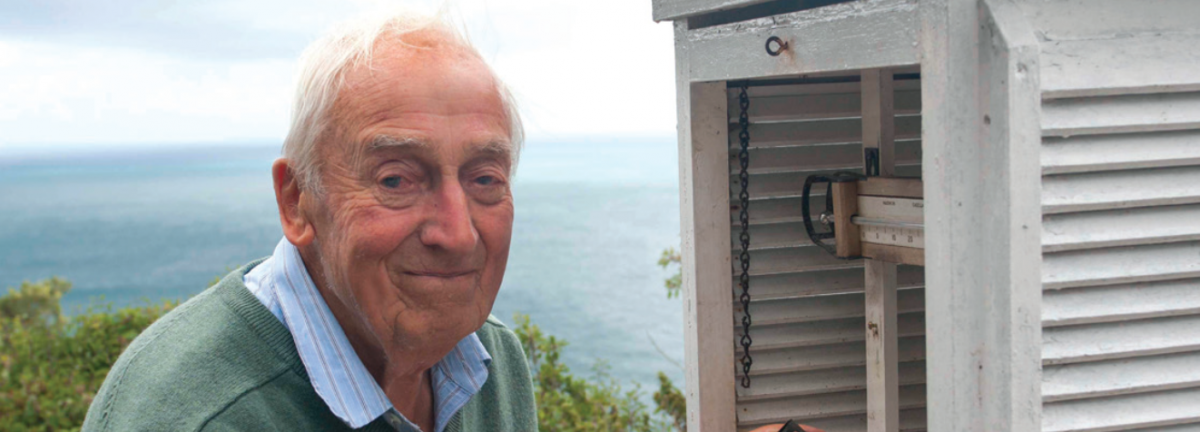“The Day They Made It Rain”: The provocative and inaccurate Title of a 2001 Radio-4 Programme. Its aim was to show that Cloud-seeding Experiments may have been responsible for the disastrous Lynmouth Flood in 1952. After a day of Torrential Rain, the West & East Lyn Rivers crushed many Homes with devastating consequences & the resulting Flood Destroyed much of that North Devon Village on the night of 15th-16th August leaving 34-people Dead & 420 homeless.

The BBC Radio Programme presented evidence of Rain-making Experiments in Southern England in the early-1950s thanks to the detailed recollections of RAF Aircrew Personnel, now long retired. These Airmen remembered Meteorologists supervising the Seeding of selected Clouds and the great satisfaction of the Scientists when Rain was subsequently Reported. It was also claimed that these Exercises were conducted in Secret, thus giving rise to the stories of Seeding Experiments by Boffins being the cause of the Disaster.
As they were drinking, the Base Telephone Rang. When news of its message spread around the Room, a stony silence fell on the Company. A Storm of tropical Intensity had broken over South-West England. 9-Inches of Rain had fallen on the already saturated Soil of Exmoor in 24-hrs & 90M tonnes of Water swept down the narrow VFalley of the East Lyn. The River burst its banks, sweeping away Bridges & Buildings in the Village of Lynmouth. 34-People died, many of them swept out to Sea by the rushing Waters. Operation Cumulus was Shut down immediately & evidence of its existence was concealed for 50-yrs.

All this falls into the “Never let the facts get in the way of a Good Story” category. Far from being Secret, Rain-making Experiments were talked about all over the place in the early-1950s. The Royal Meteorological Society’s popular Magazine, “Weather“, devoted a whole Issue to the subject in July 1952 – just a month before the Lynmouth disaster. One Article by E G Bowen described a Systematic Research Programme of artificial stimulation of Rainfall in Australia which had begun in 1947, while one of Britain’s foremost atmospheric physicists of the day, Frank Ludlam of Imperial College, described in detail the physical processes underpinning cloud-seeding research in the UK.
Any Meteorologist with a rudimentary knowledge of Cloud Seeding could explain why it is preposterous to blame the Lynmouth Flood on such Experiments. The key to understanding why this is the case is that completely different Rain-making processes are involved. Scientists involved in Rainfall Stimulation were only interested in Seeding individual Cumulus Clouds – those Cauliflower-shaped Clouds, usually less than a mile across, which sometimes produce Showers which may last 10 or 20-mins. Injecting modest amounts of dry ice or silver iodide into such a Cloud stimulates the production of Ice Crystals in the Cloud which in turn accelerates the Rain-making process. But the Cloud has to have sufficiently vigorous Updrafts to spread the Chemical throughout the Cloud. This, in turn, means that the Cloud may have eventually produced Rain in any case & the seeding merely caused it to happen earlier. For this reason, there has never been unequivocal evidence of how successful these Rain-making Programmes have been.
The Storm which caused the 1952 Disaster was not confined to the Lynmouth District. Heavy rain fell over the whole of the West Country & South Wales, & it was caused by a Depression which had Stagnated in the Southwest Approaches for 2-days. Similar Depressions have triggered Serious Flooding in South-west England at regular intervals & previous Devastating Floods hit Lynmouth in the 18th & 19thCs. The August 1952 Depression was several 100-miles Across & the prolonged Heavy Rain associated with it was caused by the large-scale Lifting of very Moist Air.
A Squadron of RAF Lancasters stuffed with Dry ice wouldn’t have made a “ha’penny’s worth” of difference to the Deluge on that day.

